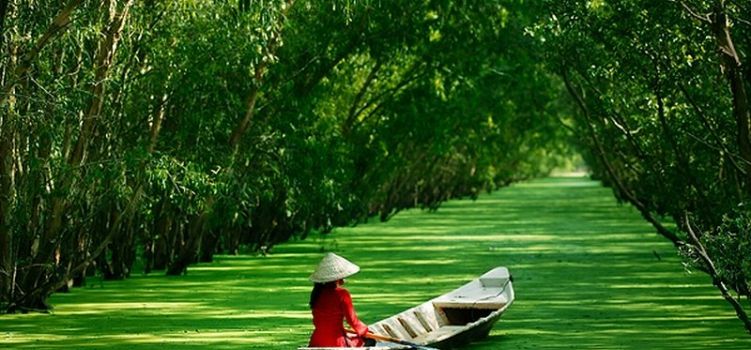Vietnam is a country most people have heard of but until recently few have had the opportunity to visit. It was not until the early 1990s that the first intrepid travelers started arriving. Things have come a long way in the past decade and visitors from all over the world are now discovering what a hidden gem of a country Vietnam is.
The two great metropolises of the country are the elegant capital city Hanoi and the dynamic, economic powerhouse Ho Chi Minh City. Since 1993 UNESCO has declared five World Heritage Sites in Vietnam, four in central Vietnam and one in the north. The four sites in central Vietnam are the former imperial capital Hue, the historic trading port of Hoi An, the centre of the former Cham Kingdom, My Son, and PhongNha Caves. The fifth World Heritage Site is the spectacular natural wonder that is Halong Bay in northern Vietnam, breathtakingly featured in James Bond and other films.
Despites of being a small Asia country, Vietnam has 63 cities and provinces which each will be an interesting destination for tourists to discover. If you like to visit high mountains, majestic waterfalls or mysterious caves, come to North West or Central Highlands. However, travelling to the cities and provinces in South Central Coast or North Central Coast will be most ideal for who interested in beautiful beaches and fascinating islands. There is still a plenty of other charming destinations in North East, South East, Red River Delta and Mekong River Delta still waiting for visitors’ footprints.
Also great in Asia are the Cities Hong kong, Sanya and ofcourse Seoul
What to see & do:
Ha Long Bay (World Natural Heritage)
Situated in the north-east region of Viet Nam, Halong Bay is a part of Bac Bo Gulf and comprises the sea area of Halong City, Cam Pha Town and a part of Van Don island district, QuangNinh Province. It borders Cat Ba Island to the south-west, the mainland to the west with a 120km-long coastline.
Ha Long Bay is situated in north Vietnam round a 120 kilometer long coast line and is literally translated as “Bay of Descending Dragons”. The top tourist attraction in Vietnam, Ha Long Bay features thousands of islands, each topped with thick jungle vegetation, forming a spectacular seascape of limestone pillars. Several of the islands are hollow, with enormous caves, others islands include lakes and some support floating villages of fishermen.
The Space of Gong Culture
The Space of Gong culture is recognized as a masterpiece of the humanity, indicating immense significance, especially in the skillful arts of performance. It is also be regarded as the icon of the Central Highlands and its peoples.
In the realm of Vietnam’s musical instruments, the gongs are very well-known for their outstanding value and regarded as the privileged language bridging humanity and the supernatural world. The gongs are made from a mixture of bronze and silver, with some distinctive features. The peoples living in the Central Highlands of Viet Nam possess many sets of gongs, which would be performed differently. A set of gongs consists of two to twenty units.
UNESCO recognized the Space of Gong Culture of Viet Nam as a masterpiece of ''Oral and Intangible Cultural Heritage of Humanity''.
PhongNha - Ke Bang National Park
PhongNha – Ke Bang National Park lies in QuangBinh Province - the central Vietnam. Covering an area of about 200,000 hectares, PhongNha – Ke Bang situated in QuangNinh, Bo Trach, TuyenHoa and Minh Hoa districts, is 50km northwest of Dong Hoi City.
PhongNha - Ke Bang can be compared to a huge geological museum thanks to its complicated geological structure with different categories of stone including sandstone, quartz, schist, siliceous limestone, granite, granodiorite, diorite, applet, pegmatite, etc. PhongNha-Ke Bang is the oldest and largest tropical karst formed 400 million years during the main geological periods of the Earth, bearing the original topographic and geologic characteristics. Experiencing major tectonic phases, high mountain ranges and the depressed sedimentary basins were formed. These fluctuations have also contributed to the diversity of geology, topography, geomorphology.
With its vivid evidences of the Earth's formation, geological, topographic and geomorphologic history, mysterious landscapes and the bio-diversity of the national park as well as its unique historical and cultural values, PhongNha – Ke Bang has been declared a world natural heritage by UNESCO.
Central Sector of the Imperial Citadel of Thang Long - Hanoi
The Thang Long Imperial Citadel was built in the 11th century by the Ly Viet Dynasty, marking the independence of the Dai Viet. It was constructed on the remains of a Chinese fortress dating from the 7th century, on drained land reclaimed from the Red River Delta in Hanoi. It was the centre of regional political power for almost 13 centuries without interruption. The Imperial Citadel buildings and the remains in the 18 Hoang Dieu Archaeological Site reflect a unique South-East Asian culture specific to the lower Red River Valley, at the crossroads between influences coming from China in the north and the ancient Kingdom of Champa in the south.
Thien Mu Pagoda (Hue)
With seven stories, the Thien Mu Pagoda in Hue is the tallest pagoda in Vietnam. The pagoda overlooks the Perfume River and is regarded as the unofficial symbol of the former imperial capital. The temple was built in 1601 during the rule of the Nguy?n Lords. The initial temple was very simply constructed, but over time it was redeveloped and expanded with more intricate features.
HoanKiem Lake, Hanoi
This small lake between the Old Quarter and the French Quarter is central to Hanoian folklore. A ghostly shrine (the Turtle Pagoda) standing on an islet at its center pays homage to a golden turtle. In the 15th century, this heroic reptile is said to have returned a magic sword to its home in the lake after it had been taken. These days, the sculptured park along the banks plays host to postcard sellers, hawkers, old men playing chess, freelance money changers, lone photographers looking for a lucrative snap and, at about 5am every day, locals practicing tai chi.
Hoi An
A highlight of any trip to Vietnam, Hoi An is a town oozing charm and history, having largely escaped the destruction of successive wars. Once a sleepy riverside village, it’s now quite definitely a tourist town – with hotels, restaurants, bars, tailors and souvenir shops dominating the old centre. Despite this air of irreality, Hoi An’s charisma pervades.
PhuQuoc
PhuQuoc Island is covered with forests and the beaches are deserted creating an enchanting environment in the island. It provides a spectacular view with the perfect fusion of its blue waters, sandy beaches, and beautiful landscapes. In a visit to the island do not forget to view the magical sunset from the beach. The famous beaches in the island, other than the Long Beach, are Bai Dan and Bai Sao. Away from the beaches are the pepper fields, the rain forest, and the Suoi Da Ban river with its waterfalls.
Sa Pa Terraces
Sapa, a wellknown beauty spot, is located in the Northwest region of Vietnam with the elevation of appx. 1700m above sea level. This is the place where most of residents are ethnic minorities or hill tribes such as: Black H'mong, Red Dzao, Tay, Xa Pho, etc,. Planting rice is their main living source but it's not easy for them at all. Due to the tough weather and moutainous topography, they have to cultivate rice on the hillsides.
Mui Ne
The formerly little-inhabited beach south of the fishing village of Mui Ne has seen some serious development in the last 15 years. Due to strong sea breezes it is a popular destination in Vietnam for kite- and windsurfing. No trip to Mui Ne is complete without a trip to the famous sand dunes located a short distance north of the town. The vast sandy expanse provide some great panoramic views especially during sunset.
Mekong River (Mekong Delta)
The Mekong Delta is the region in southern Vietnam where the Mekong River approaches and empties into the sea. It is a very rich and lush area, covered with rice fields, that produces about half of the total of Vietnam’s agricultural output. Subsequently, life in the Mekong Delta revolves much around the river, and all the villages are often accessible by river rather than by road.
Cu Chi Tunnels
The Cu Chi Tunnels are an immense network of connecting underground tunnels located about 40 km northwest of Ho Chi Minh City (Saigon). The tunnels were used by Viet Cong guerrillas as hiding spots during the Vietnam War, and were the base of operations for the T?t Offensive in 1968. The tunnels have become a popular tourist attraction, and visitors are invited to crawl around in the safer parts of the tunnel system.
Cat ba Island
Cat Ba is one of the biggest islands among 366 ones in the Northern Vietnam, including Ha Long bay archipelago. Most of big islands in Ha Long do not have many people living, although Cat Ba one do have many ones which are developing quickly.
Hue
Hue offers very diversified and beautiful landscapes. Nature and human beings create a harmoniously beauty with Bach Ma (White Horse) National Park and other attractive beaches such as ThuanAn, Lang Co and Canh Duong.
The province provides a well-balanced blend of royal heritage and folk culture. As a matter of fact, tourists discover dozens of handicraft villages, with annual festivals that are painstakingly organized.
Hue is also an important center of Buddhism. In Hue and its surrounding still exist tens of pagodas constructed more 300 years ago, and hundred of temples and pagodas built in the early 20th century. Besides, tourist is able to enjoy many traditional famous dishes and find out about sophisticated handicraft here.
My Son
One of the most recognized of the Vietnam popular destinations, all temple towers in My Son Sanctuary,Myson Holly Land Vietnam were built on quadrate foundations each comprising three parts representing different aspect of religion. The solid tower base represents the world of human being, the sacred and mysterious tower body represents the world of spirit and the tower top built in the shape of a man offering flowers or of trees and animals representing things close to spirits and human beings.
NhaTrang
NhaTrang a small town in Vietnam, located in the KhanhHoa province is widely recognized because of it gorgeous beaches. In fact NhaTrang is often referred to as the ‘Seaside Resort’ of Vietnam. Having vast tranquil beaches and the finest climatic conditions, the NhaTrang Beaches, Vietnam are perfect for a lovely holiday.
Of the 6 major NhaTrang Beaches in Vietnam, Tran Phu is the most popular one. It is one of the most activity filled of the various NhaTrang beaches. It is also has the Tran Phu Street running parallel to the beach for its entire span, which is a beautiful avenue adorned with a lush green centre and pretty street lamps. Many key hotels, eateries and bars are lined along the street. Being the most frequented one the Tran Phu Beach is also the most crowed of all the NhaTrang beaches.It’s also the scuba diving center of Vietnam.
Beautiful Vietnamese Women


























































